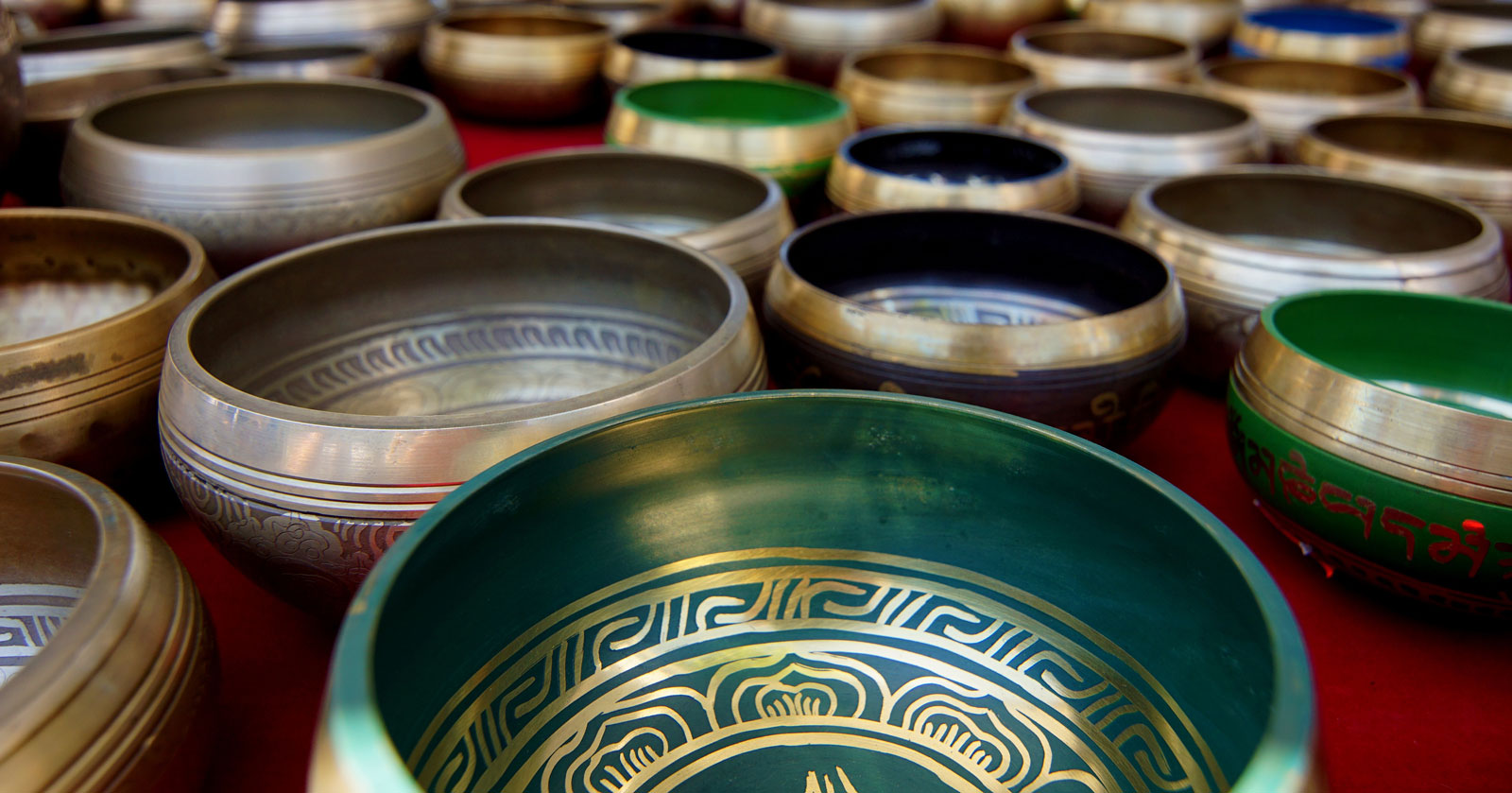Singing bowls
Melodic Percussions
America
Between 1001 and 1900 AD
Video
Singing bowls, also known as Tibetan singing bowls or Himalayan bowls, are a unique type of musical instrument that has captivated audiences worldwide with their rich, resonant sounds. These bowls are not only used for music but also play a significant role in meditation, healing practices, and spiritual rituals. Their enchanting tones have made them popular in various cultures, especially in the realms of wellness and mindfulness.
Description and Features
Singing bowls are typically made from a combination of metal alloys, often including copper and tin, though some may contain other metals such as silver or gold. They come in various sizes, ranging from small bowls that fit comfortably in the palm of your hand to larger bowls that can weigh several pounds. The size and material of the bowl significantly influence its sound quality and pitch.When played, singing bowls produce a range of sounds that can be both soothing and invigorating. The sound is generated either by striking the bowl with a mallet or by rubbing the rim with a padded mallet, creating a continuous tone that can resonate for an extended period. This sustained sound is often described as “singing,” hence the name.The tonal quality of singing bowls is characterized by a fundamental note accompanied by a series of overtones. This complexity allows for a rich auditory experience, making them suitable for both musical compositions and therapeutic applications. The vibrations produced by singing bowls can be felt physically, creating a sense of connection to the sound.
History and Origin
The history of singing bowls is deeply intertwined with the spiritual practices of Tibetan Buddhism. Although their exact origins are difficult to trace, it is believed that singing bowls have been used for thousands of years in the Himalayan region. They were traditionally crafted by skilled artisans who employed ancient techniques passed down through generations.Singing bowls were originally used by monks during meditation and rituals to enhance spiritual practices. They were believed to facilitate deep states of relaxation and mindfulness, helping practitioners focus their thoughts and achieve a heightened state of awareness. The use of singing bowls in spiritual contexts contributed to their association with healing and wellness.In the late 20th century, singing bowls began to gain popularity outside of traditional settings as Western interest in Eastern spirituality grew.
They became widely recognized as tools for meditation and sound therapy, leading to their incorporation into yoga classes, wellness retreats, and holistic healing practices.As more people discovered the benefits of singing bowls, they became commercially available in various forms, including decorative pieces and musical instruments. Today, they are celebrated not only for their aesthetic beauty but also for their therapeutic properties.
Working Mechanism
The working mechanism of singing bowls is based on the principles of acoustics and vibration. When a bowl is struck with a mallet, it vibrates at specific frequencies, producing sound waves that travel through the air. These vibrations create both a fundamental tone and a series of overtones that contribute to the bowl’s unique sound profile.To play a singing bowl effectively, one can use two primary techniques: striking and rubbing. Striking involves hitting the bowl with a mallet to produce an immediate sound. This method is often used to initiate sound during meditation sessions or performances.Rubbing involves gently moving a padded mallet around the rim of the bowl in a circular motion. This technique generates continuous vibrations that create a sustained tone. The speed and pressure applied during this process can alter the volume and quality of the sound produced.The physical properties of the bowl—such as its size, shape, and material—play crucial roles in determining its tonal characteristics. Larger bowls tend to produce deeper sounds with longer sustain, while smaller bowls often yield higher pitches with shorter resonance times.
Types of Singing Bowls
Singing bowls can be categorized into several types based on their materials, construction methods, and intended uses:
- Traditional Metal Singing Bowls: These are typically made from various metal alloys and are handcrafted using ancient techniques. They are often used in meditation practices due to their rich tonal qualities.
- Crystal Singing Bowls: Made from high-purity quartz crystal, these bowls produce clear tones that resonate beautifully. They are popular in sound therapy sessions because they create harmonic frequencies that can enhance relaxation.
- Tibetan Singing Bowls: Originating from Tibet, these bowls are known for their unique craftsmanship and spiritual significance. They are often used in Buddhist rituals and meditation practices.
- Therapeutic Singing Bowls: Designed specifically for sound healing practices, these bowls may be made from various materials but are chosen for their ability to produce specific frequencies beneficial for healing.
Each type serves different purposes and appeals to various preferences among users.
Music Composed with Singing Bowls
Singing bowls have found their way into diverse musical compositions across genres. While they were traditionally used in spiritual contexts, contemporary musicians have embraced them as instruments capable of adding depth and texture to music.In traditional settings, singing bowls accompany chants or meditative music during spiritual ceremonies or yoga classes. Their soothing tones create an atmosphere conducive to relaxation and mindfulness.In modern music compositions, artists incorporate singing bowls into ambient music genres or world music styles. Their unique sounds blend harmoniously with other instruments such as flutes or guitars, creating ethereal soundscapes that transport listeners into tranquil states.Moreover, many musicians utilize singing bowls in live performances or recordings aimed at promoting healing or relaxation. The combination of visual beauty and auditory pleasure makes them captivating additions to concerts or wellness events.
Significance of Singing Bowls
The significance of singing bowls extends beyond their musical capabilities; they embody cultural heritage and spiritual practices. In many Eastern traditions, playing singing bowls is not just about producing sound; it represents a form of meditation that fosters connection between mind and body.In therapeutic contexts, singing bowls have gained recognition for their potential benefits in promoting relaxation and reducing stress levels. Sound therapy practitioners use these instruments to facilitate healing experiences for individuals seeking relief from anxiety or physical discomfort.
Furthermore, as global interest in mindfulness practices grows, singing bowls serve as powerful tools for fostering awareness and presence in everyday life. Their ability to create calming atmospheres makes them valuable assets in yoga studios, wellness centers, and personal meditation spaces.In summary, singing bowls are more than mere musical instruments; they are vessels of sound that carry profound cultural significance while offering therapeutic benefits to those who engage with them.
FAQ
What is the Singing bowl made of?
Singing bowls are traditionally made from a metal alloy, often referred to as "bell metal," which typically includes a combination of bronze, brass, or other metals such as copper, tin, zinc, silver, gold, and iron. The precise composition can vary depending on the cultural and artisanal traditions. Modern singing bowls, particularly crystal singing bowls, are crafted from quartz crystal or silica sand.
When were singing bowls invented?
Singing bowls were invented over 2,000 years ago, with origins traced to the Himalayan regions, including Nepal and Tibet. They were traditionally used in Buddhist practices for meditation, prayer, and healing. Their exact historical timeline is unclear, but they are believed to have evolved alongside spiritual and cultural traditions in the region.
What is the traditional name for a singing bowl?
Singing bowls were invented over 2,000 years ago, with origins traced to the Himalayan regions, including Nepal and Tibet. They were traditionally used in Buddhist practices for meditation, prayer, and healing. Their exact historical timeline is unclear, but they are believed to have evolved alongside spiritual and cultural traditions in the region.
 Links
Links
References
Other Instrument
Categories



















